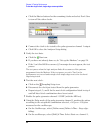
40
Chapter 3: Testing Performance
To test the single-clock, single-edge, state acquisition
Verify the test signal
1 Check the clock period. Using the oscilloscope, verify that the master-to-
master clock time is 5.000 ns, +0 ps or −100 ps:
a In the oscilloscope Timebase menu, select Scale: 1.000 ns/div.
b In the oscilloscope Timebase menu, select Position. Using the
oscilloscope knob, position the clock waveform so that a rising edge
appears at the left of the display.
c On the oscilloscope, select [Shift] Period: channel 2, then select [Enter]
to display the clock period (Period(2)). If the period is not less than
5.000 ns, go to step d. If the period is less than 5.000 ns, go to step 2.
d In the oscilloscope Timebase menu, increase Position 5.000 ns. If the
period is not less than 5.000 ns, decrease the pulse generator Period in
until one of the two periods measured is less than 5.000 ns.
2 Check the data pulse width. Using the oscilloscope, verify that the data
pulse width is 2.500 ns, +0 ps or −100 ps.
a In the oscilloscope Timebase menu, select Position. Using the
oscilloscope knob, position the data waveform so that the waveform is
centered on the screen.
b On the oscilloscope, select [Shift] + width: channel 1, then select
[Enter] to display the data signal pulse width (+ width(1)).


















